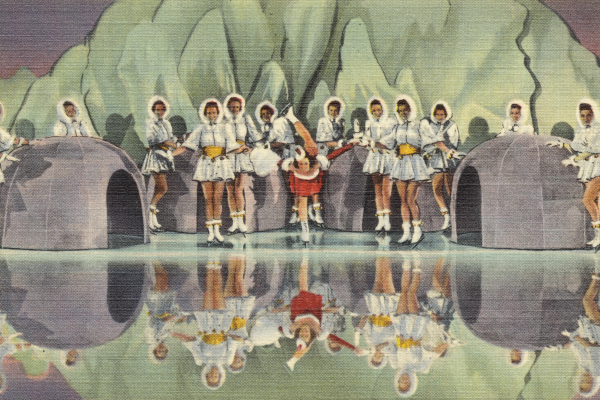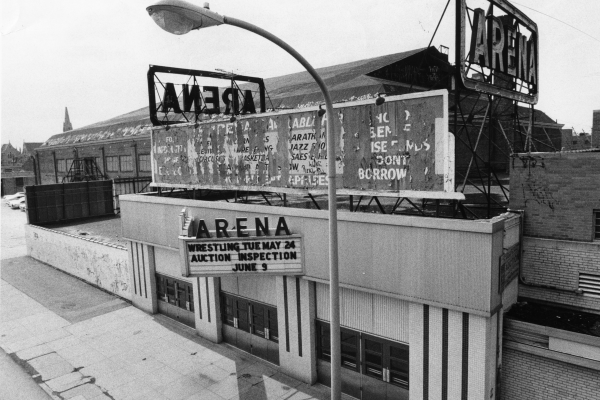The Peak Years of the Arena
Part of
The Arena reached its peak in the post-war years with the emergence of professional basketball.
The Arena’s attendance peaked after World War II thanks to Philadelphia’s increasing population and the introduction of professional basketball. In 1947, the Arena began hosting basketball games in addition to its standard fare of boxing, ice hockey, and ice shows. It served as the home court for the Philadelphia Warriors as well as the Philadelphia Ramblers and the Philadelphia Rockets—drawing crowds larger than its seating capacity. The Arena's owners upgraded the stadium with a fresh coat of paint and a new sign but added no additional seating to accommodate the large number of basketball fans.
After the war, the Arena continued to function as a primary locale for sports and indoor entertainment, serving a quickly increasing population thanks to the post-war baby boom and waves of the Great Migration of African Americans leaving the Jim Crow South, which accelerated during the war and for a decade thereafter.
Once the Second World War ended, the Ramblers resumed playing ice hockey at the Arena and boxing continued. Also at this time, the Arena introduced professional basketball to West Philadelphia when Eddie Gottlieb and the Arena Corporation (the organization that purchased the Arena during the Great Depression) created the Philadelphia Warriors.[1] The Philadelphia Warriors became a charter member of the Basketball Association of America (BAA), a forerunner to today’s National Basketball Association (NBA) under the management of Gottlieb and ownership by the Arena Corporation.[2]
In their inaugural season, the Warriors won the BAA’s first championship, defeating the Chicago Stags in a five-game series before a crowd of 8,221 spectators.[3] The Arena would serve as the primary home court for the Warriors until 1952, when the Warriors would begin to split their time between the Civic Center and the Arena—an arrangement the team would maintain until the Warriors were sold and left Philadelphia for San Francisco in 1962.[4]
The Philadelphia Ramblers were joined at the Arena by another minor league hockey team, the Philadelphia Rockets. The Rockets folded after only three years, and the Ramblers followed suit in 1949.[5] The Ramblers would reappear in 1956 at the Arena, re-forming again as the New York Rangers minor league team in the Eastern Hockey League.[6] This iteration of the Ramblers took part in an historic matchup at the Arena with the vaunted Soviet Union team in 1963, with the Ramblers losing 12–2.[7] The third edition of the Ramblers was only slightly more successful than its immediate predecessor, suffering from dwindling crowds and changes in management; the team left the Arena for Cherry Hill, New Jersey in 1964.[8]
Despite continuing flux in its professional sports teams during this period, the Arena remained a major entertainment venue in Philadelphia. Reflecting on his tenure as the Arena’s manager since the late 1920s and part-owner since the late 1930s, Pete Tyrell noted that the Arena would have closed during the Great Depression had it not been for the Ice Capades and the Ice Follies, shows that continued to draw the Arena’s largest crowds.[9]
Besides the ice shows, the Arena regularly hosted Roy Rogers rodeos. In a somber service for a rider who had died falling from a bronco during a show, the rodeo staged a rodeo funeral for the young cowgirl, featuring a riderless horse next to the casket. In addition to rodeos, dance marathons continued, one of which included a marriage with the bride and groom dancing down the aisle.[10] Professional wrestling became a regular feature, plays and operas on tour were performed, a circus regularly set up its big-top under the Arena’s roof, Her Majesty’s Scottish Guard performed, Elvis Presley gave a concert, roller derbies raced, and evangelists preached.[11]
The Warriors’ decision in the mid-1950s to play on an alternating basis at the Civic Center, located just south of the University of Pennsylvania, exposed a serious problem for the Arena. Its relatively small capacity of only 9,000 could not hold the large crowds the Warriors were able to draw. Another problem was delayed renovations—the Arena was pejoratively dubbed “the Brick Pile.” The Arena underwent its first major upgrade in nearly 40 years in 1959, when it received a new marquee and a fresh coat of paint.[12] The upgrade did not expand seating capacity. Remaining the only facility in Philadelphia with a floor capacity to host ice shows, the Arena was still able to attract large crowds. Beginning in the early 1960s, however, proposals were floated in the city to build a new, more capacious, ice-friendly facility.[13] Though these plans did not materialize for many years, they underscored the limitations of the Arena.

